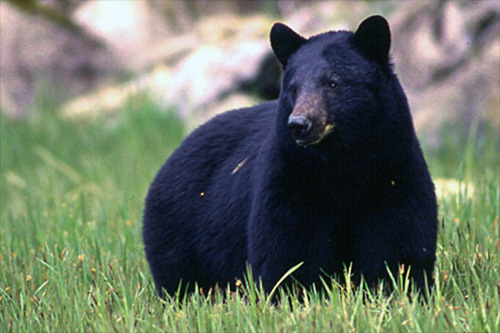
(Stock photo from the Alaska Department of Fish and Game.)
Summer in Alaska brings more opportunities for hiking, fishing and recreating outdoors — and a better chance of seeing a bear along the way. Biologists say a few simple tips can keep hikers and bears safe.
Picture this: you’re walking down a trail on a misty Southeast Alaska day, minding your own business, when suddenly you see the dark outline of a black bear. You might panic, sure, but biologist Ross Dorendorf with the state’s Department of Fish and Game, says it’s a better idea to simply stop and assess the situation.
“It wants to get from point A to point B, so do you,” Dorendorf said. “And when that happens, when you first make contact with a bear, what you want to do is decide whether or not it knows you’re there.”
If the bear has not seen you, Dorendorf says to slowly begin to go another way, giving the bear a wide berth — and even more if it’s a mother with cubs.
On the other hand, if a bear has noticed you, U.S. Forest Service biologist Ben Limle says it is important to speak to the animal in a calm, firm voice. Giving it space is also important, says Dorendorf.
“So to give space, you want to stand your ground and talk calmly to that bear in a defensive situation, ‘Hey bear, sorry bear,” Dorendorf explained. “And that kind of deescalates the situation, both for the bear and yourself.”
Ideally, the bear would lose interest in the situation and leave the area. If it doesn’t, continue to stand your ground.
“If the bear starts coming at you again, when you’re making that slow backup, you want to stop again, stand your ground, and talk in a calm voice,” Dorendorf said. “And hopefully that will diffuse things. If it doesn’t, the worst case scenario is the bear comes at you.”
That’s when bear deterrent like bear spray could be used. Limle says they’re typically most effective when the bear is about 30 feet away.
But failing that, if a bear knocks you down, it might be time to “play dead,” says Dorendorf.
“The way you do that is you would interlace your fingers, put them over the back of your neck, to protect your neck, and you would fall to the ground,” Dorendorf said. “Face down, stomach down to the ground, protecting your vital organs, and splaying your feet slightly to ensure that you kind of stabilize yourself.”
In some situations, like when a lone bear may perceive you as food, biologists recommend fighting back, focusing on the bear’s face or muzzle.
As for pets, Limle says dogs have been known to scare away bears, but it could cause more danger to you and your pet to allow them off leash in bear territory. He says he keeps his own dog restrained while outdoors.
“For me personally and as a wildlife biologist I don’t want to put the bear through that stressful situation as well, so I like to keep my animal leashed and with me and I can help control the situation,” Limle said.
No matter what type of activity brings you outdoors this summer, biologists say it’s best to stay bear aware.
A public education event about how to use inert bear deterrent and practice bear safety is set for 5:30 p.m. Friday at the Southeast Alaska Discovery Center.
Raegan Miller is a Report for America corps member for KRBD. Your donation to match our RFA grant helps keep her writing stories like this one. Please consider making a tax-deductible contribution at KRBD.org/donate.





